2019 Business Finance: Traditional Budgeting and Alternative Methods
VerifiedAdded on 2023/02/01
|13
|3622
|62
Report
AI Summary
This report, prepared for a Business Finance module, examines traditional budgeting methods and alternative approaches like rolling, zero-based, and activity-based budgeting. The report begins with an introduction to budgeting, its purpose, and its importance in planning, performance management, and control. It then delves into the application of traditional budgeting, including incremental budgeting, and its limitations, particularly for companies like SnappyDrinks Plc, which is looking to introduce a new product. The report further explores alternative budgeting methods such as rolling budgets and activity-based and zero-based budgeting, evaluating their advantages and disadvantages. The analysis includes the application of these methods for planning future cost management, resource allocation, and financial forecasting. The report concludes by comparing the effectiveness of various budgeting techniques and suggesting the most suitable methods for different business scenarios, providing a comprehensive overview of budgeting strategies and their practical applications.
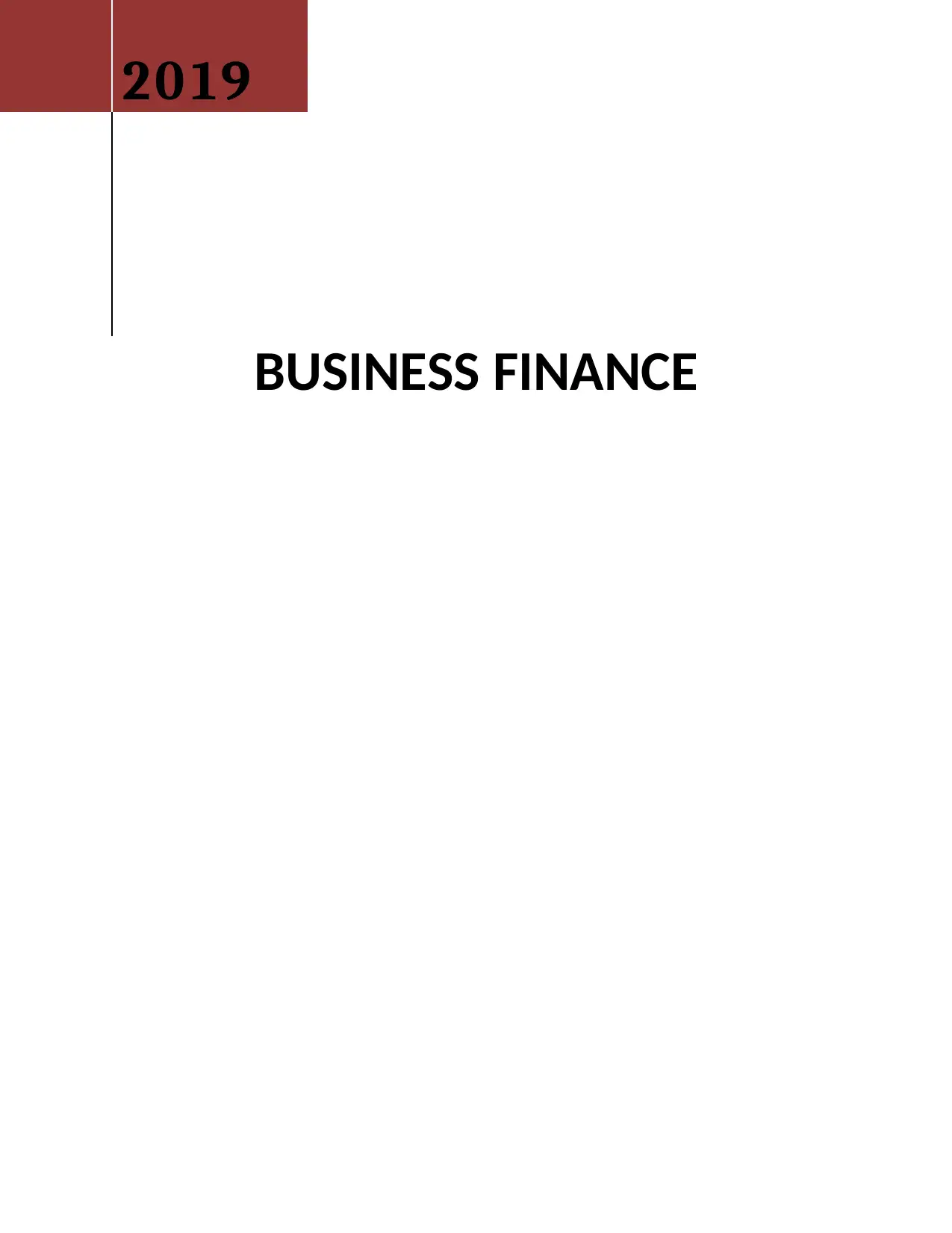
BUSINESS FINANCE
2019
2019
Paraphrase This Document
Need a fresh take? Get an instant paraphrase of this document with our AI Paraphraser
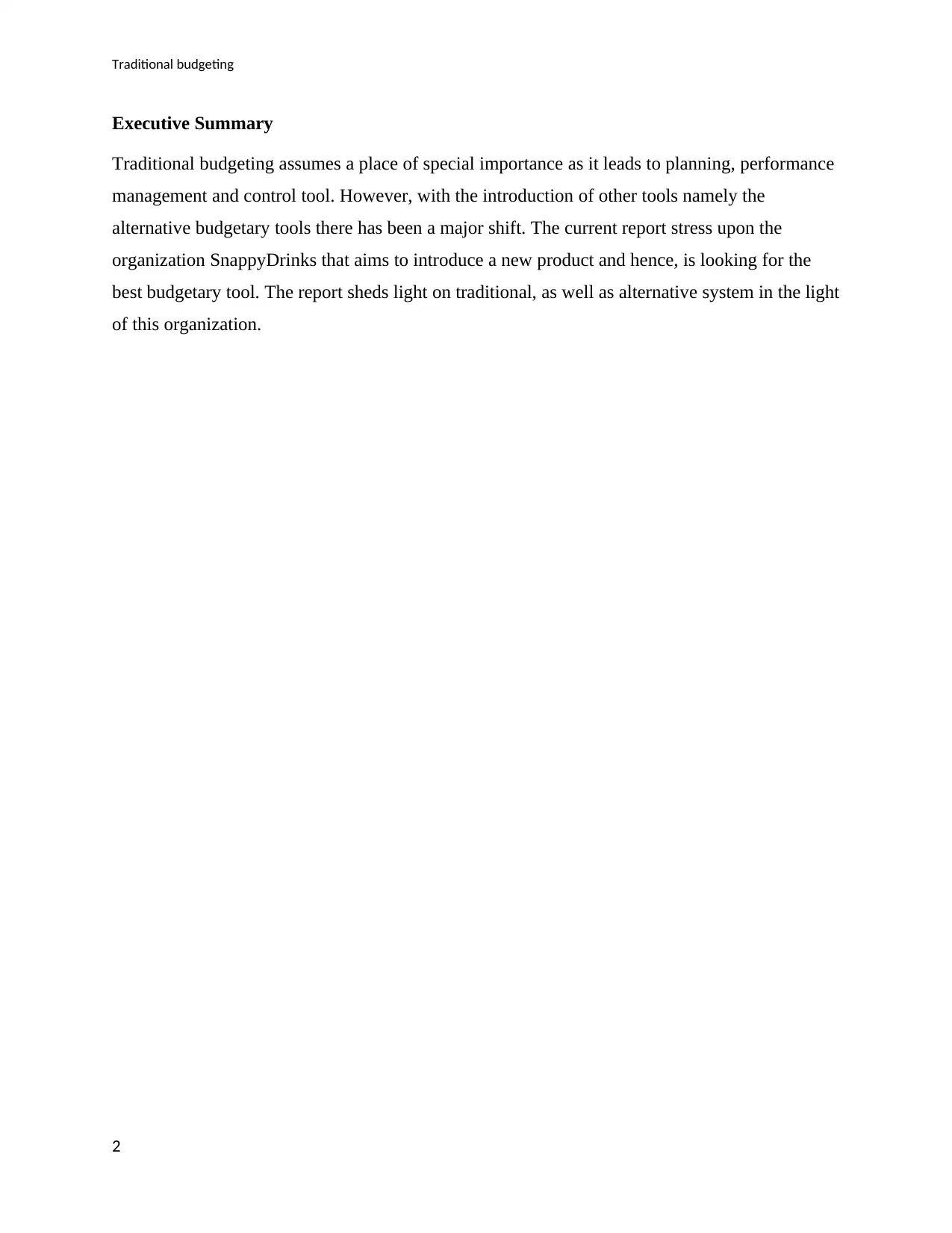
Traditional budgeting
Executive Summary
Traditional budgeting assumes a place of special importance as it leads to planning, performance
management and control tool. However, with the introduction of other tools namely the
alternative budgetary tools there has been a major shift. The current report stress upon the
organization SnappyDrinks that aims to introduce a new product and hence, is looking for the
best budgetary tool. The report sheds light on traditional, as well as alternative system in the light
of this organization.
2
Executive Summary
Traditional budgeting assumes a place of special importance as it leads to planning, performance
management and control tool. However, with the introduction of other tools namely the
alternative budgetary tools there has been a major shift. The current report stress upon the
organization SnappyDrinks that aims to introduce a new product and hence, is looking for the
best budgetary tool. The report sheds light on traditional, as well as alternative system in the light
of this organization.
2
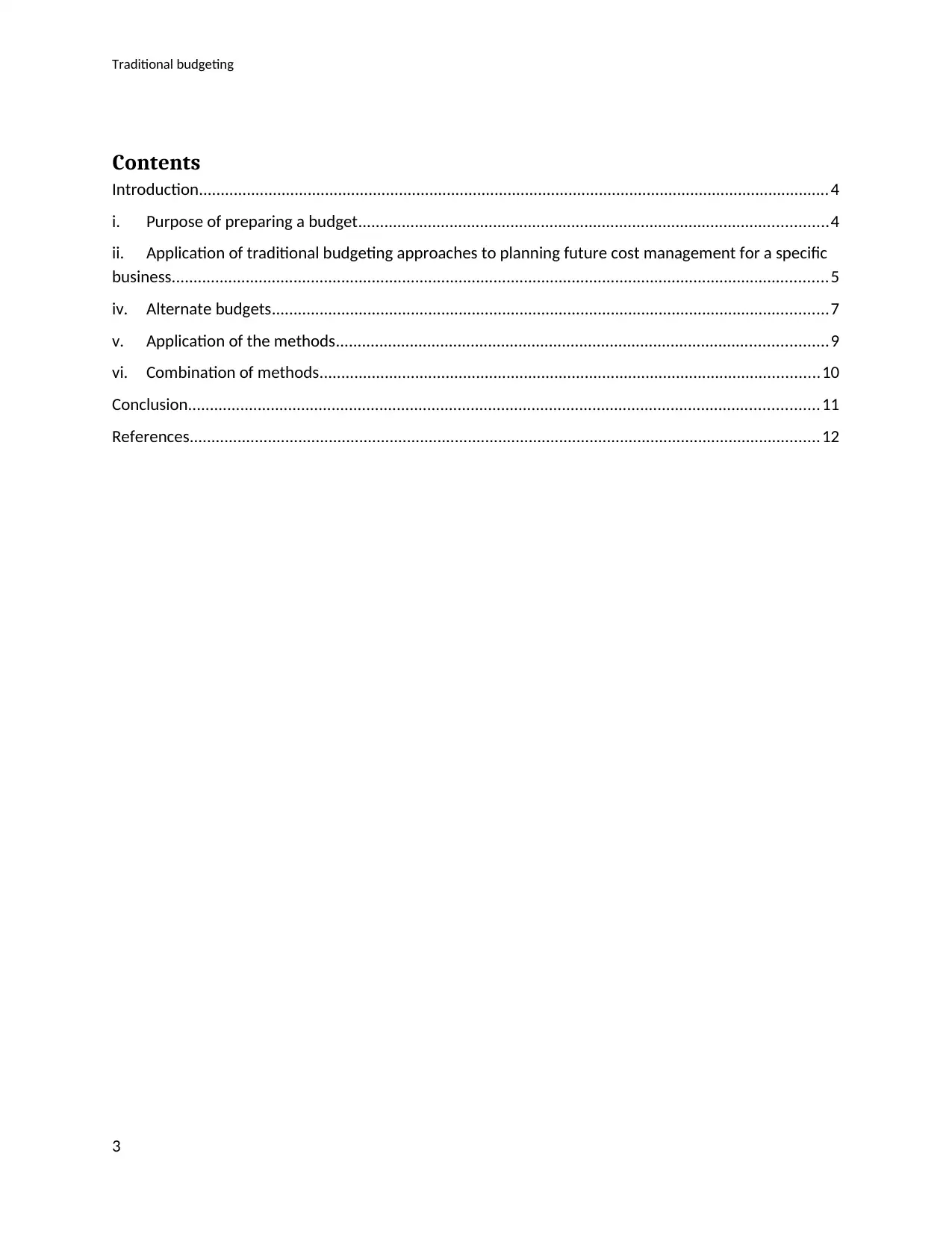
Traditional budgeting
Contents
Introduction.................................................................................................................................................4
i. Purpose of preparing a budget............................................................................................................4
ii. Application of traditional budgeting approaches to planning future cost management for a specific
business.......................................................................................................................................................5
iv. Alternate budgets................................................................................................................................7
v. Application of the methods.................................................................................................................9
vi. Combination of methods...................................................................................................................10
Conclusion.................................................................................................................................................11
References.................................................................................................................................................12
3
Contents
Introduction.................................................................................................................................................4
i. Purpose of preparing a budget............................................................................................................4
ii. Application of traditional budgeting approaches to planning future cost management for a specific
business.......................................................................................................................................................5
iv. Alternate budgets................................................................................................................................7
v. Application of the methods.................................................................................................................9
vi. Combination of methods...................................................................................................................10
Conclusion.................................................................................................................................................11
References.................................................................................................................................................12
3
⊘ This is a preview!⊘
Do you want full access?
Subscribe today to unlock all pages.

Trusted by 1+ million students worldwide
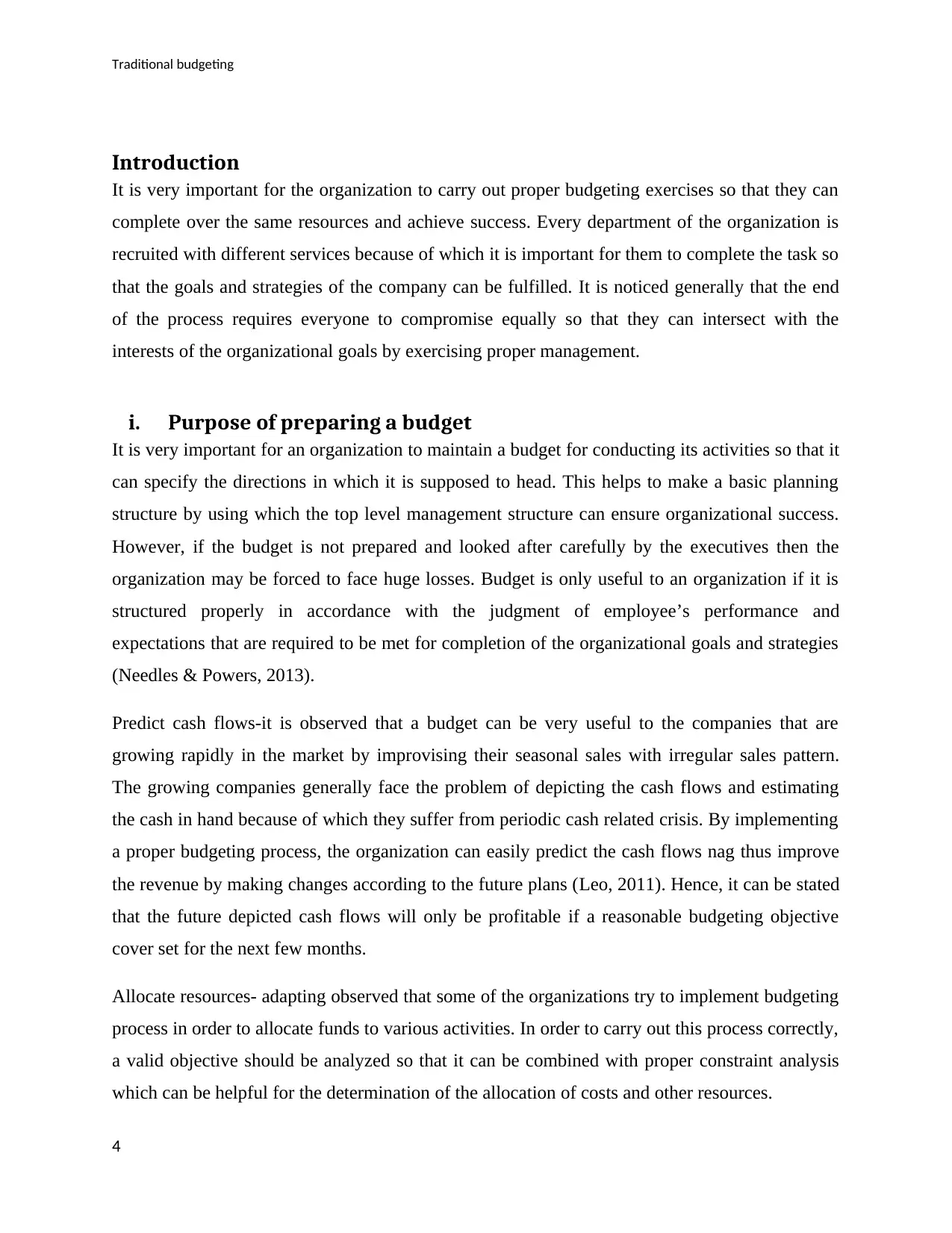
Traditional budgeting
Introduction
It is very important for the organization to carry out proper budgeting exercises so that they can
complete over the same resources and achieve success. Every department of the organization is
recruited with different services because of which it is important for them to complete the task so
that the goals and strategies of the company can be fulfilled. It is noticed generally that the end
of the process requires everyone to compromise equally so that they can intersect with the
interests of the organizational goals by exercising proper management.
i. Purpose of preparing a budget
It is very important for an organization to maintain a budget for conducting its activities so that it
can specify the directions in which it is supposed to head. This helps to make a basic planning
structure by using which the top level management structure can ensure organizational success.
However, if the budget is not prepared and looked after carefully by the executives then the
organization may be forced to face huge losses. Budget is only useful to an organization if it is
structured properly in accordance with the judgment of employee’s performance and
expectations that are required to be met for completion of the organizational goals and strategies
(Needles & Powers, 2013).
Predict cash flows-it is observed that a budget can be very useful to the companies that are
growing rapidly in the market by improvising their seasonal sales with irregular sales pattern.
The growing companies generally face the problem of depicting the cash flows and estimating
the cash in hand because of which they suffer from periodic cash related crisis. By implementing
a proper budgeting process, the organization can easily predict the cash flows nag thus improve
the revenue by making changes according to the future plans (Leo, 2011). Hence, it can be stated
that the future depicted cash flows will only be profitable if a reasonable budgeting objective
cover set for the next few months.
Allocate resources- adapting observed that some of the organizations try to implement budgeting
process in order to allocate funds to various activities. In order to carry out this process correctly,
a valid objective should be analyzed so that it can be combined with proper constraint analysis
which can be helpful for the determination of the allocation of costs and other resources.
4
Introduction
It is very important for the organization to carry out proper budgeting exercises so that they can
complete over the same resources and achieve success. Every department of the organization is
recruited with different services because of which it is important for them to complete the task so
that the goals and strategies of the company can be fulfilled. It is noticed generally that the end
of the process requires everyone to compromise equally so that they can intersect with the
interests of the organizational goals by exercising proper management.
i. Purpose of preparing a budget
It is very important for an organization to maintain a budget for conducting its activities so that it
can specify the directions in which it is supposed to head. This helps to make a basic planning
structure by using which the top level management structure can ensure organizational success.
However, if the budget is not prepared and looked after carefully by the executives then the
organization may be forced to face huge losses. Budget is only useful to an organization if it is
structured properly in accordance with the judgment of employee’s performance and
expectations that are required to be met for completion of the organizational goals and strategies
(Needles & Powers, 2013).
Predict cash flows-it is observed that a budget can be very useful to the companies that are
growing rapidly in the market by improvising their seasonal sales with irregular sales pattern.
The growing companies generally face the problem of depicting the cash flows and estimating
the cash in hand because of which they suffer from periodic cash related crisis. By implementing
a proper budgeting process, the organization can easily predict the cash flows nag thus improve
the revenue by making changes according to the future plans (Leo, 2011). Hence, it can be stated
that the future depicted cash flows will only be profitable if a reasonable budgeting objective
cover set for the next few months.
Allocate resources- adapting observed that some of the organizations try to implement budgeting
process in order to allocate funds to various activities. In order to carry out this process correctly,
a valid objective should be analyzed so that it can be combined with proper constraint analysis
which can be helpful for the determination of the allocation of costs and other resources.
4
Paraphrase This Document
Need a fresh take? Get an instant paraphrase of this document with our AI Paraphraser
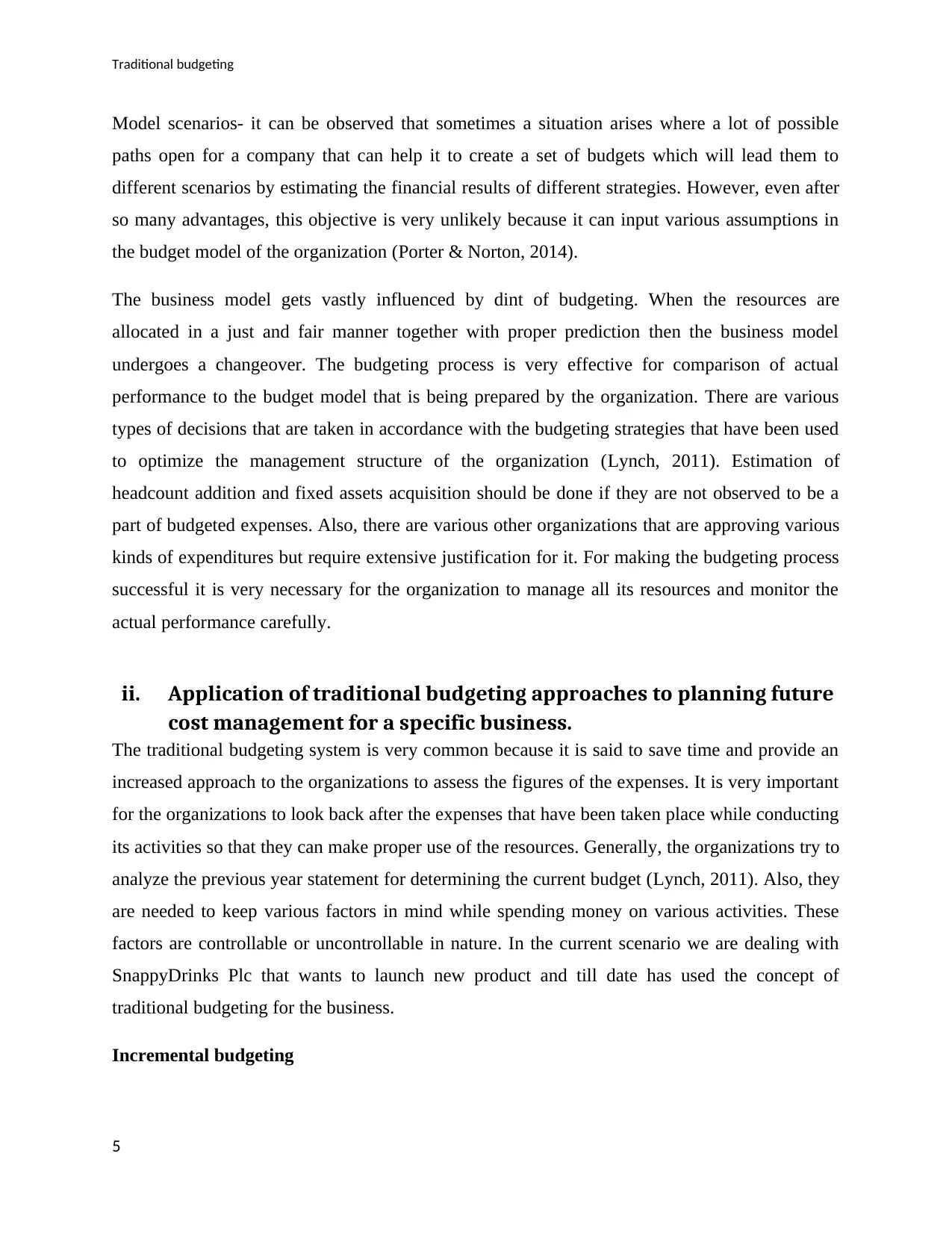
Traditional budgeting
Model scenarios- it can be observed that sometimes a situation arises where a lot of possible
paths open for a company that can help it to create a set of budgets which will lead them to
different scenarios by estimating the financial results of different strategies. However, even after
so many advantages, this objective is very unlikely because it can input various assumptions in
the budget model of the organization (Porter & Norton, 2014).
The business model gets vastly influenced by dint of budgeting. When the resources are
allocated in a just and fair manner together with proper prediction then the business model
undergoes a changeover. The budgeting process is very effective for comparison of actual
performance to the budget model that is being prepared by the organization. There are various
types of decisions that are taken in accordance with the budgeting strategies that have been used
to optimize the management structure of the organization (Lynch, 2011). Estimation of
headcount addition and fixed assets acquisition should be done if they are not observed to be a
part of budgeted expenses. Also, there are various other organizations that are approving various
kinds of expenditures but require extensive justification for it. For making the budgeting process
successful it is very necessary for the organization to manage all its resources and monitor the
actual performance carefully.
ii. Application of traditional budgeting approaches to planning future
cost management for a specific business.
The traditional budgeting system is very common because it is said to save time and provide an
increased approach to the organizations to assess the figures of the expenses. It is very important
for the organizations to look back after the expenses that have been taken place while conducting
its activities so that they can make proper use of the resources. Generally, the organizations try to
analyze the previous year statement for determining the current budget (Lynch, 2011). Also, they
are needed to keep various factors in mind while spending money on various activities. These
factors are controllable or uncontrollable in nature. In the current scenario we are dealing with
SnappyDrinks Plc that wants to launch new product and till date has used the concept of
traditional budgeting for the business.
Incremental budgeting
5
Model scenarios- it can be observed that sometimes a situation arises where a lot of possible
paths open for a company that can help it to create a set of budgets which will lead them to
different scenarios by estimating the financial results of different strategies. However, even after
so many advantages, this objective is very unlikely because it can input various assumptions in
the budget model of the organization (Porter & Norton, 2014).
The business model gets vastly influenced by dint of budgeting. When the resources are
allocated in a just and fair manner together with proper prediction then the business model
undergoes a changeover. The budgeting process is very effective for comparison of actual
performance to the budget model that is being prepared by the organization. There are various
types of decisions that are taken in accordance with the budgeting strategies that have been used
to optimize the management structure of the organization (Lynch, 2011). Estimation of
headcount addition and fixed assets acquisition should be done if they are not observed to be a
part of budgeted expenses. Also, there are various other organizations that are approving various
kinds of expenditures but require extensive justification for it. For making the budgeting process
successful it is very necessary for the organization to manage all its resources and monitor the
actual performance carefully.
ii. Application of traditional budgeting approaches to planning future
cost management for a specific business.
The traditional budgeting system is very common because it is said to save time and provide an
increased approach to the organizations to assess the figures of the expenses. It is very important
for the organizations to look back after the expenses that have been taken place while conducting
its activities so that they can make proper use of the resources. Generally, the organizations try to
analyze the previous year statement for determining the current budget (Lynch, 2011). Also, they
are needed to keep various factors in mind while spending money on various activities. These
factors are controllable or uncontrollable in nature. In the current scenario we are dealing with
SnappyDrinks Plc that wants to launch new product and till date has used the concept of
traditional budgeting for the business.
Incremental budgeting
5
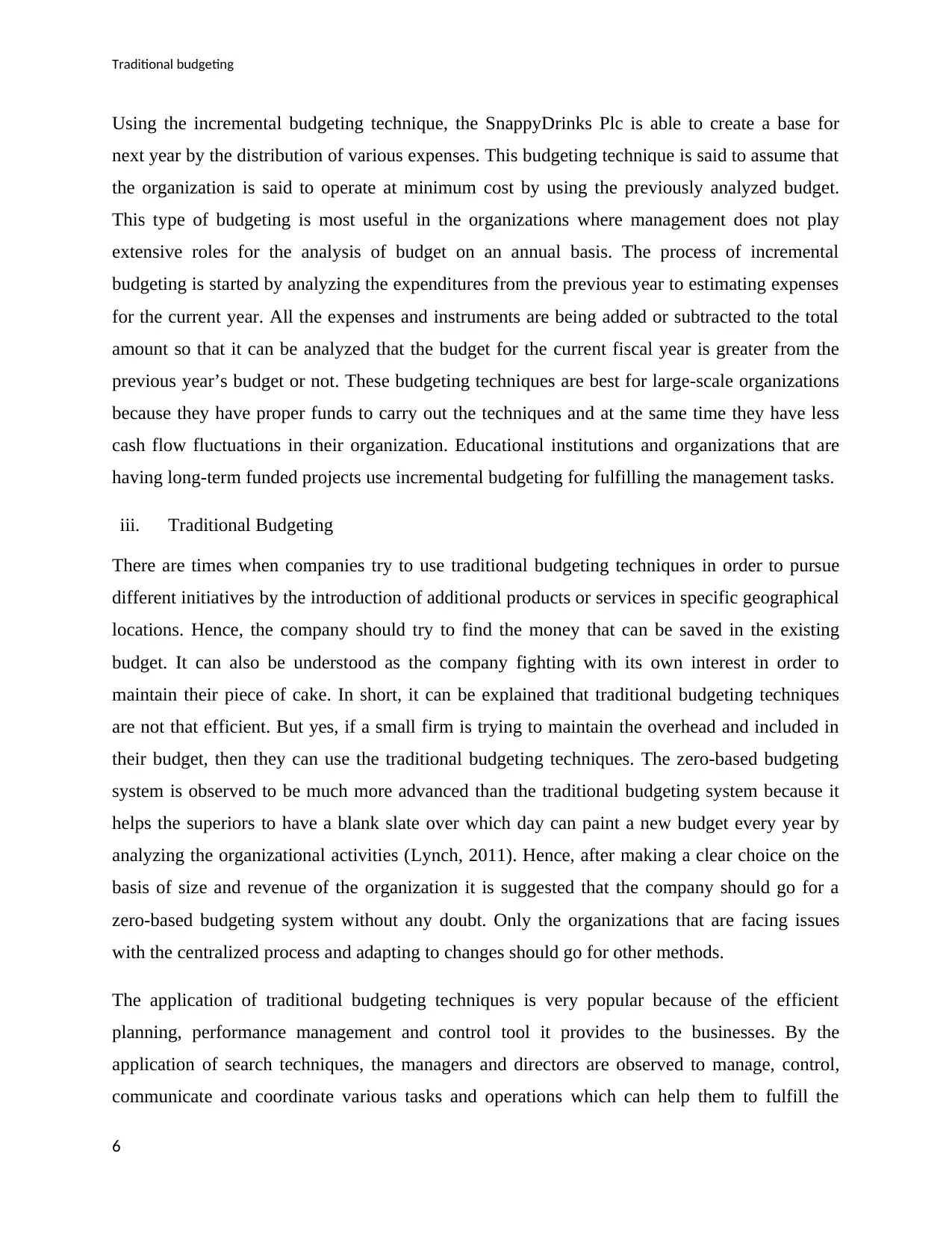
Traditional budgeting
Using the incremental budgeting technique, the SnappyDrinks Plc is able to create a base for
next year by the distribution of various expenses. This budgeting technique is said to assume that
the organization is said to operate at minimum cost by using the previously analyzed budget.
This type of budgeting is most useful in the organizations where management does not play
extensive roles for the analysis of budget on an annual basis. The process of incremental
budgeting is started by analyzing the expenditures from the previous year to estimating expenses
for the current year. All the expenses and instruments are being added or subtracted to the total
amount so that it can be analyzed that the budget for the current fiscal year is greater from the
previous year’s budget or not. These budgeting techniques are best for large-scale organizations
because they have proper funds to carry out the techniques and at the same time they have less
cash flow fluctuations in their organization. Educational institutions and organizations that are
having long-term funded projects use incremental budgeting for fulfilling the management tasks.
iii. Traditional Budgeting
There are times when companies try to use traditional budgeting techniques in order to pursue
different initiatives by the introduction of additional products or services in specific geographical
locations. Hence, the company should try to find the money that can be saved in the existing
budget. It can also be understood as the company fighting with its own interest in order to
maintain their piece of cake. In short, it can be explained that traditional budgeting techniques
are not that efficient. But yes, if a small firm is trying to maintain the overhead and included in
their budget, then they can use the traditional budgeting techniques. The zero-based budgeting
system is observed to be much more advanced than the traditional budgeting system because it
helps the superiors to have a blank slate over which day can paint a new budget every year by
analyzing the organizational activities (Lynch, 2011). Hence, after making a clear choice on the
basis of size and revenue of the organization it is suggested that the company should go for a
zero-based budgeting system without any doubt. Only the organizations that are facing issues
with the centralized process and adapting to changes should go for other methods.
The application of traditional budgeting techniques is very popular because of the efficient
planning, performance management and control tool it provides to the businesses. By the
application of search techniques, the managers and directors are observed to manage, control,
communicate and coordinate various tasks and operations which can help them to fulfill the
6
Using the incremental budgeting technique, the SnappyDrinks Plc is able to create a base for
next year by the distribution of various expenses. This budgeting technique is said to assume that
the organization is said to operate at minimum cost by using the previously analyzed budget.
This type of budgeting is most useful in the organizations where management does not play
extensive roles for the analysis of budget on an annual basis. The process of incremental
budgeting is started by analyzing the expenditures from the previous year to estimating expenses
for the current year. All the expenses and instruments are being added or subtracted to the total
amount so that it can be analyzed that the budget for the current fiscal year is greater from the
previous year’s budget or not. These budgeting techniques are best for large-scale organizations
because they have proper funds to carry out the techniques and at the same time they have less
cash flow fluctuations in their organization. Educational institutions and organizations that are
having long-term funded projects use incremental budgeting for fulfilling the management tasks.
iii. Traditional Budgeting
There are times when companies try to use traditional budgeting techniques in order to pursue
different initiatives by the introduction of additional products or services in specific geographical
locations. Hence, the company should try to find the money that can be saved in the existing
budget. It can also be understood as the company fighting with its own interest in order to
maintain their piece of cake. In short, it can be explained that traditional budgeting techniques
are not that efficient. But yes, if a small firm is trying to maintain the overhead and included in
their budget, then they can use the traditional budgeting techniques. The zero-based budgeting
system is observed to be much more advanced than the traditional budgeting system because it
helps the superiors to have a blank slate over which day can paint a new budget every year by
analyzing the organizational activities (Lynch, 2011). Hence, after making a clear choice on the
basis of size and revenue of the organization it is suggested that the company should go for a
zero-based budgeting system without any doubt. Only the organizations that are facing issues
with the centralized process and adapting to changes should go for other methods.
The application of traditional budgeting techniques is very popular because of the efficient
planning, performance management and control tool it provides to the businesses. By the
application of search techniques, the managers and directors are observed to manage, control,
communicate and coordinate various tasks and operations which can help them to fulfill the
6
⊘ This is a preview!⊘
Do you want full access?
Subscribe today to unlock all pages.

Trusted by 1+ million students worldwide

Traditional budgeting
organizational goals and strategies without sharing authority with the other subsections of the
company (Emmanuel, 2014). There are various organizations cultures and management
mentalities who are trying to use the traditional budgeting techniques for improvising their
managerial workforce.
Part 2
iv. Alternate budgets
Rolling budget
Rolling forecast is one of the most common and important alternatives to traditional budgeting
techniques because it helps us to create a situation where the budget is cast with the help of
monthly, quarterly or half-yearly forecasting rates. It has been clearly stated by various
economics that the process of budgeting is very important for the organization to secure its
future. Hence, the process of budgeting should be taken as a primary task by the organization.
The rolling forecast is said to provide a framework for the organization so that it can depict its
future and plan accordingly. It has an organization to create a doable plan that can be very useful
for it to execute in accordance with the current situations that are being observed by the firm
(Emmanuel, 2014). It not only helps the organization to analyze the current situation but also
helps to depict the future by estimation of likely events that can be faced by the organization.
Rolling forecast helps to provide the real picture to the organization by the help of which forecast
can be created for a particular time period by analyzing the events and this helps in the process of
traditional budgeting. This will also provide the organization to have an opportunity to analyze
data of different periods and make future forecasts accordingly (Laux, 2014).
The major drawback of rolling budget lies in the fact that it extends the budget that is original.
Hence, rolling budget cannot be termed as static in nature and continues on a perpetual basis. For
a long term perspective, this budget is not feasible and hence, is not suited to the organization for
long term planning.
Activity-based budgeting
7
organizational goals and strategies without sharing authority with the other subsections of the
company (Emmanuel, 2014). There are various organizations cultures and management
mentalities who are trying to use the traditional budgeting techniques for improvising their
managerial workforce.
Part 2
iv. Alternate budgets
Rolling budget
Rolling forecast is one of the most common and important alternatives to traditional budgeting
techniques because it helps us to create a situation where the budget is cast with the help of
monthly, quarterly or half-yearly forecasting rates. It has been clearly stated by various
economics that the process of budgeting is very important for the organization to secure its
future. Hence, the process of budgeting should be taken as a primary task by the organization.
The rolling forecast is said to provide a framework for the organization so that it can depict its
future and plan accordingly. It has an organization to create a doable plan that can be very useful
for it to execute in accordance with the current situations that are being observed by the firm
(Emmanuel, 2014). It not only helps the organization to analyze the current situation but also
helps to depict the future by estimation of likely events that can be faced by the organization.
Rolling forecast helps to provide the real picture to the organization by the help of which forecast
can be created for a particular time period by analyzing the events and this helps in the process of
traditional budgeting. This will also provide the organization to have an opportunity to analyze
data of different periods and make future forecasts accordingly (Laux, 2014).
The major drawback of rolling budget lies in the fact that it extends the budget that is original.
Hence, rolling budget cannot be termed as static in nature and continues on a perpetual basis. For
a long term perspective, this budget is not feasible and hence, is not suited to the organization for
long term planning.
Activity-based budgeting
7
Paraphrase This Document
Need a fresh take? Get an instant paraphrase of this document with our AI Paraphraser

Traditional budgeting
Activity-based budgeting system is adopted on a budgeting system approach that determines the
number of inputs that are required for completion of the target output that is being set by the
organization. It can be understood with an example of a company was trying to generate an
output target of a hundred million dollars of revenue (Drury, 2011). The organization will first
have to determine all the activities that will be undertaken for the fulfillment of the target, and
then it will find the cost of the activities and make the budget accordingly. As SnappyDrinks
produces more than 60 products and wants to launch the new one therefore this budgeting helps
in determination of activities from the previous products and ensure the budget.
The major disadvantage that can be witnessed in this case is that its implementation requires
software and hence, is a costly affair. On the other hand, other types of budgeting do not need
softwares for the implementation.
Zero-based budgeting
Zero-based budgeting is one of the most commonly used methods because is observed to assume
that the budget of all departments are zero and are to be rebuilt from the very start. Also, the
managers are asked to justify every single expense so that the budget can be kept intact in nature
by avoiding any kind of irrelevant expenditure that is not at all profitable for the company’s
revenue structure (Brown, 2013). The step of budgeting techniques is very helpful for the
organizations to check the things up from starting and carry out all the tasks and procedures in an
effective way by incurring least expenses.
Thus, the zero base approach is very useful for urgent determination of cost function that Snappy
drinks require so that the company can restructure the financial factors of the organization. The
major economic growth on a market downturn can be observed by reducing the budget in an
appropriate manner (Brown, 2013). This budgeting technique is also very appropriate for the
application of various costs rather than essential operating costs.
The zero-based budgeting technique is very time-consuming because of which very fewer
organizations observed to practice it.
8
Activity-based budgeting system is adopted on a budgeting system approach that determines the
number of inputs that are required for completion of the target output that is being set by the
organization. It can be understood with an example of a company was trying to generate an
output target of a hundred million dollars of revenue (Drury, 2011). The organization will first
have to determine all the activities that will be undertaken for the fulfillment of the target, and
then it will find the cost of the activities and make the budget accordingly. As SnappyDrinks
produces more than 60 products and wants to launch the new one therefore this budgeting helps
in determination of activities from the previous products and ensure the budget.
The major disadvantage that can be witnessed in this case is that its implementation requires
software and hence, is a costly affair. On the other hand, other types of budgeting do not need
softwares for the implementation.
Zero-based budgeting
Zero-based budgeting is one of the most commonly used methods because is observed to assume
that the budget of all departments are zero and are to be rebuilt from the very start. Also, the
managers are asked to justify every single expense so that the budget can be kept intact in nature
by avoiding any kind of irrelevant expenditure that is not at all profitable for the company’s
revenue structure (Brown, 2013). The step of budgeting techniques is very helpful for the
organizations to check the things up from starting and carry out all the tasks and procedures in an
effective way by incurring least expenses.
Thus, the zero base approach is very useful for urgent determination of cost function that Snappy
drinks require so that the company can restructure the financial factors of the organization. The
major economic growth on a market downturn can be observed by reducing the budget in an
appropriate manner (Brown, 2013). This budgeting technique is also very appropriate for the
application of various costs rather than essential operating costs.
The zero-based budgeting technique is very time-consuming because of which very fewer
organizations observed to practice it.
8
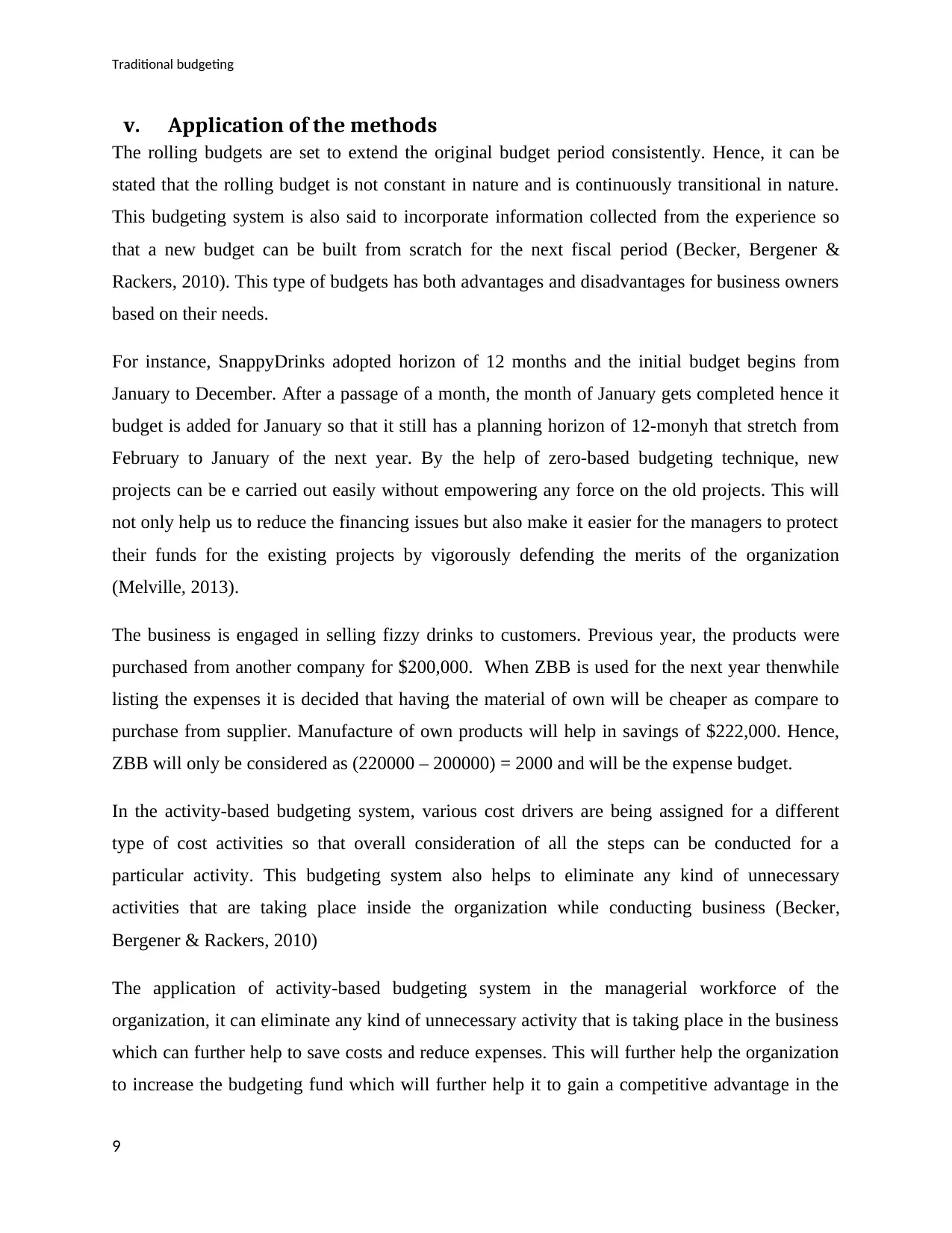
Traditional budgeting
v. Application of the methods
The rolling budgets are set to extend the original budget period consistently. Hence, it can be
stated that the rolling budget is not constant in nature and is continuously transitional in nature.
This budgeting system is also said to incorporate information collected from the experience so
that a new budget can be built from scratch for the next fiscal period (Becker, Bergener &
Rackers, 2010). This type of budgets has both advantages and disadvantages for business owners
based on their needs.
For instance, SnappyDrinks adopted horizon of 12 months and the initial budget begins from
January to December. After a passage of a month, the month of January gets completed hence it
budget is added for January so that it still has a planning horizon of 12-monyh that stretch from
February to January of the next year. By the help of zero-based budgeting technique, new
projects can be e carried out easily without empowering any force on the old projects. This will
not only help us to reduce the financing issues but also make it easier for the managers to protect
their funds for the existing projects by vigorously defending the merits of the organization
(Melville, 2013).
The business is engaged in selling fizzy drinks to customers. Previous year, the products were
purchased from another company for $200,000. When ZBB is used for the next year thenwhile
listing the expenses it is decided that having the material of own will be cheaper as compare to
purchase from supplier. Manufacture of own products will help in savings of $222,000. Hence,
ZBB will only be considered as (220000 – 200000) = 2000 and will be the expense budget.
In the activity-based budgeting system, various cost drivers are being assigned for a different
type of cost activities so that overall consideration of all the steps can be conducted for a
particular activity. This budgeting system also helps to eliminate any kind of unnecessary
activities that are taking place inside the organization while conducting business (Becker,
Bergener & Rackers, 2010)
The application of activity-based budgeting system in the managerial workforce of the
organization, it can eliminate any kind of unnecessary activity that is taking place in the business
which can further help to save costs and reduce expenses. This will further help the organization
to increase the budgeting fund which will further help it to gain a competitive advantage in the
9
v. Application of the methods
The rolling budgets are set to extend the original budget period consistently. Hence, it can be
stated that the rolling budget is not constant in nature and is continuously transitional in nature.
This budgeting system is also said to incorporate information collected from the experience so
that a new budget can be built from scratch for the next fiscal period (Becker, Bergener &
Rackers, 2010). This type of budgets has both advantages and disadvantages for business owners
based on their needs.
For instance, SnappyDrinks adopted horizon of 12 months and the initial budget begins from
January to December. After a passage of a month, the month of January gets completed hence it
budget is added for January so that it still has a planning horizon of 12-monyh that stretch from
February to January of the next year. By the help of zero-based budgeting technique, new
projects can be e carried out easily without empowering any force on the old projects. This will
not only help us to reduce the financing issues but also make it easier for the managers to protect
their funds for the existing projects by vigorously defending the merits of the organization
(Melville, 2013).
The business is engaged in selling fizzy drinks to customers. Previous year, the products were
purchased from another company for $200,000. When ZBB is used for the next year thenwhile
listing the expenses it is decided that having the material of own will be cheaper as compare to
purchase from supplier. Manufacture of own products will help in savings of $222,000. Hence,
ZBB will only be considered as (220000 – 200000) = 2000 and will be the expense budget.
In the activity-based budgeting system, various cost drivers are being assigned for a different
type of cost activities so that overall consideration of all the steps can be conducted for a
particular activity. This budgeting system also helps to eliminate any kind of unnecessary
activities that are taking place inside the organization while conducting business (Becker,
Bergener & Rackers, 2010)
The application of activity-based budgeting system in the managerial workforce of the
organization, it can eliminate any kind of unnecessary activity that is taking place in the business
which can further help to save costs and reduce expenses. This will further help the organization
to increase the budgeting fund which will further help it to gain a competitive advantage in the
9
⊘ This is a preview!⊘
Do you want full access?
Subscribe today to unlock all pages.

Trusted by 1+ million students worldwide

Traditional budgeting
market. The activity-based costing method helps the organization to act as a single unit
(Merchant, 2012). This approach does not divide the departments of the organization and further
refers to the managers and the top management to be the same which is generally not considered
in the other methods of budgeting (Balakrishnan, Labro & Soderstrom, 2016).
ABC will be more suited to the organization owing to the fact it helps in providing more realistic
budget and accuracy in the need of resources. For instance, the activities will be identified.
Further, the cost driver that is associated with each element is traced. A cost rate is done with
the assignment of costs. The management for example requires 100000 pieces of cans that will
need overhead costs of $200000 for the year. Such overhead costs will comprise of salaries ,
purchase and store. Machine set ups will need 400 setups and overheads $80000. The company
will need 4000 inspections and overheads of $400000. In totality, running machines will need
$600000 for 20000 machine hours.
vi. Combination of methods
The main focus of organizations nowadays is to eliminate weaknesses of traditional budgeting
system so that they can get a proper approach to the organizational operations. Hence, by
improving the budgeting practices and considering value creation in the rapidly changing
environment, the organizations can utilize traditional budgeting with other budgeting this view of
traditional budgeting system will be helpful for various organizations in the current business
environment (Balakrishnan, Labro & Soderstrom, 2016). Hence, going by the overall scenario, it
can be seen that the alternative method of budgeting comprises of different methods and each has
its own pros and cons.
However, going by the entire scenario, it is imperative that the method of budget will depend
entirely upon the presence of different scenario. If there are different products in the pipeline and
of complex nature then the company should vouch for a combination of the methods that will
help in providing a better forecast and analysis. The best part in terms of using a combination of
different method lies in the fact that each division can be evaluated with ease. This leads to
betterment and helps in generating the best result (Parrino, Kidwell, & Bates, 2012). The
presence of a combination of the above methods gives rise to innumerable advantages and hence,
is a better option to the company.
10
market. The activity-based costing method helps the organization to act as a single unit
(Merchant, 2012). This approach does not divide the departments of the organization and further
refers to the managers and the top management to be the same which is generally not considered
in the other methods of budgeting (Balakrishnan, Labro & Soderstrom, 2016).
ABC will be more suited to the organization owing to the fact it helps in providing more realistic
budget and accuracy in the need of resources. For instance, the activities will be identified.
Further, the cost driver that is associated with each element is traced. A cost rate is done with
the assignment of costs. The management for example requires 100000 pieces of cans that will
need overhead costs of $200000 for the year. Such overhead costs will comprise of salaries ,
purchase and store. Machine set ups will need 400 setups and overheads $80000. The company
will need 4000 inspections and overheads of $400000. In totality, running machines will need
$600000 for 20000 machine hours.
vi. Combination of methods
The main focus of organizations nowadays is to eliminate weaknesses of traditional budgeting
system so that they can get a proper approach to the organizational operations. Hence, by
improving the budgeting practices and considering value creation in the rapidly changing
environment, the organizations can utilize traditional budgeting with other budgeting this view of
traditional budgeting system will be helpful for various organizations in the current business
environment (Balakrishnan, Labro & Soderstrom, 2016). Hence, going by the overall scenario, it
can be seen that the alternative method of budgeting comprises of different methods and each has
its own pros and cons.
However, going by the entire scenario, it is imperative that the method of budget will depend
entirely upon the presence of different scenario. If there are different products in the pipeline and
of complex nature then the company should vouch for a combination of the methods that will
help in providing a better forecast and analysis. The best part in terms of using a combination of
different method lies in the fact that each division can be evaluated with ease. This leads to
betterment and helps in generating the best result (Parrino, Kidwell, & Bates, 2012). The
presence of a combination of the above methods gives rise to innumerable advantages and hence,
is a better option to the company.
10
Paraphrase This Document
Need a fresh take? Get an instant paraphrase of this document with our AI Paraphraser
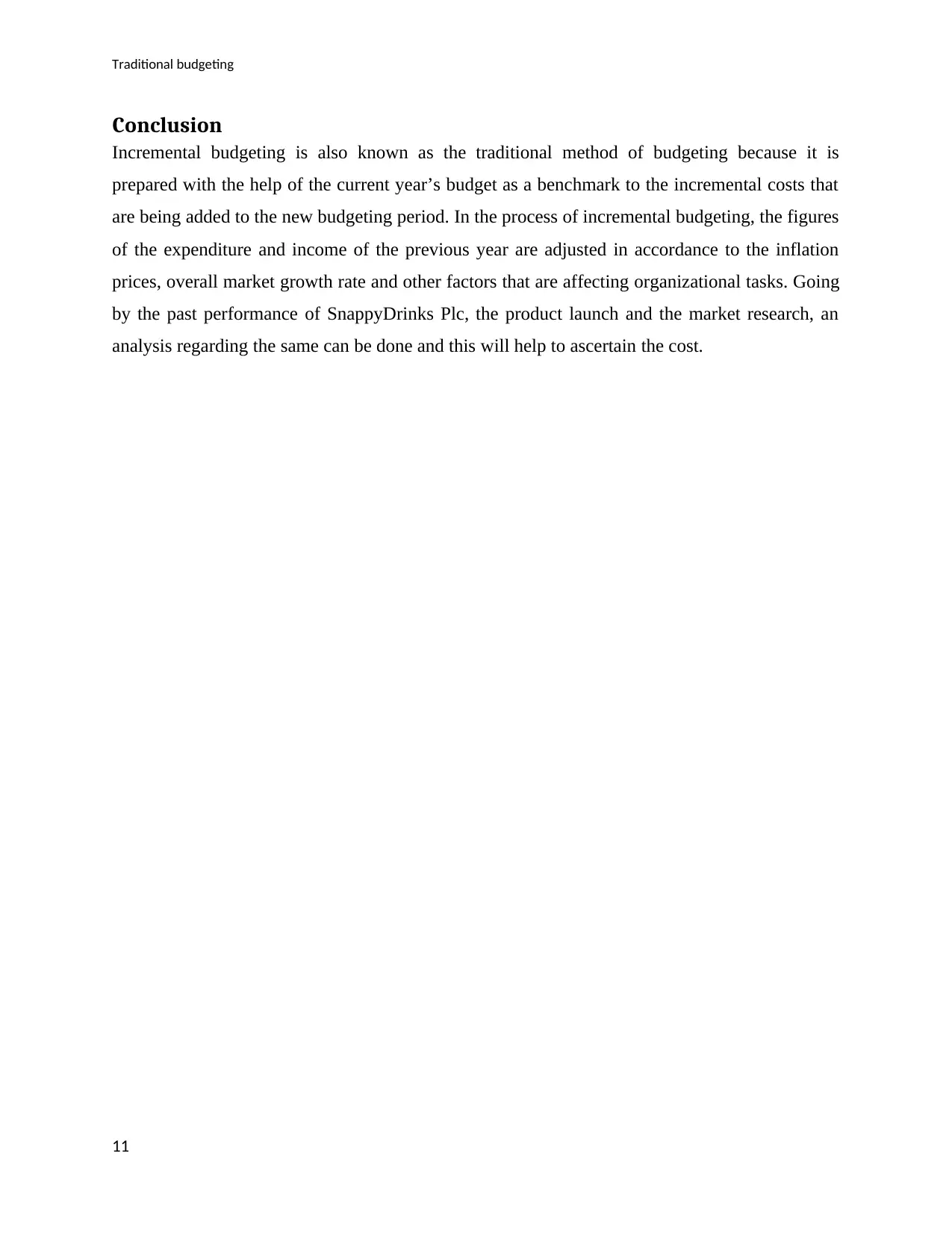
Traditional budgeting
Conclusion
Incremental budgeting is also known as the traditional method of budgeting because it is
prepared with the help of the current year’s budget as a benchmark to the incremental costs that
are being added to the new budgeting period. In the process of incremental budgeting, the figures
of the expenditure and income of the previous year are adjusted in accordance to the inflation
prices, overall market growth rate and other factors that are affecting organizational tasks. Going
by the past performance of SnappyDrinks Plc, the product launch and the market research, an
analysis regarding the same can be done and this will help to ascertain the cost.
11
Conclusion
Incremental budgeting is also known as the traditional method of budgeting because it is
prepared with the help of the current year’s budget as a benchmark to the incremental costs that
are being added to the new budgeting period. In the process of incremental budgeting, the figures
of the expenditure and income of the previous year are adjusted in accordance to the inflation
prices, overall market growth rate and other factors that are affecting organizational tasks. Going
by the past performance of SnappyDrinks Plc, the product launch and the market research, an
analysis regarding the same can be done and this will help to ascertain the cost.
11
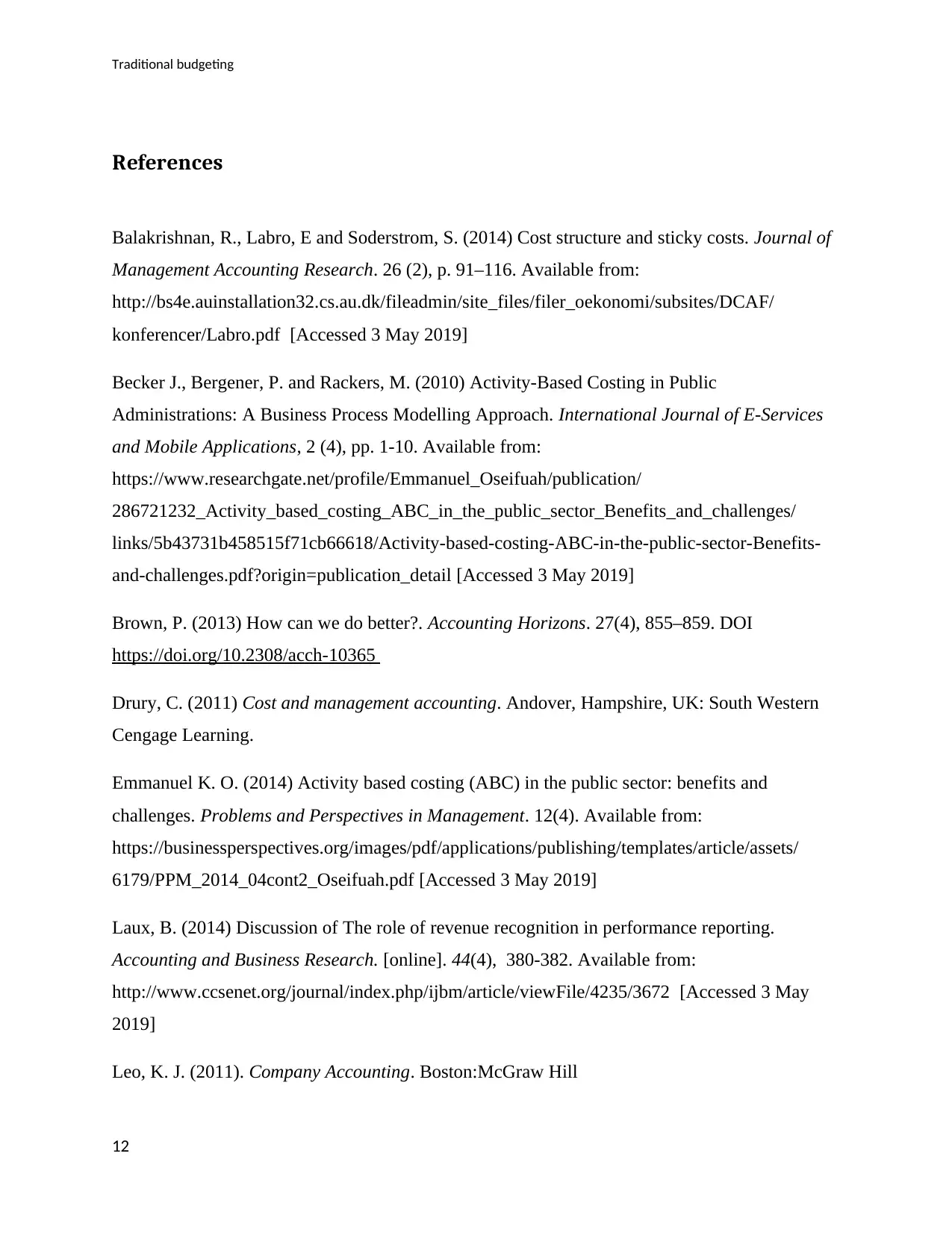
Traditional budgeting
References
Balakrishnan, R., Labro, E and Soderstrom, S. (2014) Cost structure and sticky costs. Journal of
Management Accounting Research. 26 (2), p. 91–116. Available from:
http://bs4e.auinstallation32.cs.au.dk/fileadmin/site_files/filer_oekonomi/subsites/DCAF/
konferencer/Labro.pdf [Accessed 3 May 2019]
Becker J., Bergener, P. and Rackers, M. (2010) Activity-Based Costing in Public
Administrations: A Business Process Modelling Approach. International Journal of E-Services
and Mobile Applications, 2 (4), pp. 1-10. Available from:
https://www.researchgate.net/profile/Emmanuel_Oseifuah/publication/
286721232_Activity_based_costing_ABC_in_the_public_sector_Benefits_and_challenges/
links/5b43731b458515f71cb66618/Activity-based-costing-ABC-in-the-public-sector-Benefits-
and-challenges.pdf?origin=publication_detail [Accessed 3 May 2019]
Brown, P. (2013) How can we do better?. Accounting Horizons. 27(4), 855–859. DOI
https://doi.org/10.2308/acch-10365
Drury, C. (2011) Cost and management accounting. Andover, Hampshire, UK: South Western
Cengage Learning.
Emmanuel K. O. (2014) Activity based costing (ABC) in the public sector: benefits and
challenges. Problems and Perspectives in Management. 12(4). Available from:
https://businessperspectives.org/images/pdf/applications/publishing/templates/article/assets/
6179/PPM_2014_04cont2_Oseifuah.pdf [Accessed 3 May 2019]
Laux, B. (2014) Discussion of The role of revenue recognition in performance reporting.
Accounting and Business Research. [online]. 44(4), 380-382. Available from:
http://www.ccsenet.org/journal/index.php/ijbm/article/viewFile/4235/3672 [Accessed 3 May
2019]
Leo, K. J. (2011). Company Accounting. Boston:McGraw Hill
12
References
Balakrishnan, R., Labro, E and Soderstrom, S. (2014) Cost structure and sticky costs. Journal of
Management Accounting Research. 26 (2), p. 91–116. Available from:
http://bs4e.auinstallation32.cs.au.dk/fileadmin/site_files/filer_oekonomi/subsites/DCAF/
konferencer/Labro.pdf [Accessed 3 May 2019]
Becker J., Bergener, P. and Rackers, M. (2010) Activity-Based Costing in Public
Administrations: A Business Process Modelling Approach. International Journal of E-Services
and Mobile Applications, 2 (4), pp. 1-10. Available from:
https://www.researchgate.net/profile/Emmanuel_Oseifuah/publication/
286721232_Activity_based_costing_ABC_in_the_public_sector_Benefits_and_challenges/
links/5b43731b458515f71cb66618/Activity-based-costing-ABC-in-the-public-sector-Benefits-
and-challenges.pdf?origin=publication_detail [Accessed 3 May 2019]
Brown, P. (2013) How can we do better?. Accounting Horizons. 27(4), 855–859. DOI
https://doi.org/10.2308/acch-10365
Drury, C. (2011) Cost and management accounting. Andover, Hampshire, UK: South Western
Cengage Learning.
Emmanuel K. O. (2014) Activity based costing (ABC) in the public sector: benefits and
challenges. Problems and Perspectives in Management. 12(4). Available from:
https://businessperspectives.org/images/pdf/applications/publishing/templates/article/assets/
6179/PPM_2014_04cont2_Oseifuah.pdf [Accessed 3 May 2019]
Laux, B. (2014) Discussion of The role of revenue recognition in performance reporting.
Accounting and Business Research. [online]. 44(4), 380-382. Available from:
http://www.ccsenet.org/journal/index.php/ijbm/article/viewFile/4235/3672 [Accessed 3 May
2019]
Leo, K. J. (2011). Company Accounting. Boston:McGraw Hill
12
⊘ This is a preview!⊘
Do you want full access?
Subscribe today to unlock all pages.

Trusted by 1+ million students worldwide
1 out of 13
Related Documents
Your All-in-One AI-Powered Toolkit for Academic Success.
+13062052269
info@desklib.com
Available 24*7 on WhatsApp / Email
![[object Object]](/_next/static/media/star-bottom.7253800d.svg)
Unlock your academic potential
Copyright © 2020–2025 A2Z Services. All Rights Reserved. Developed and managed by ZUCOL.





